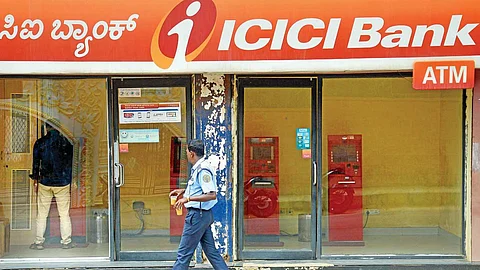

MUMBAI: The second largest private sector lender ICICI Bank on Saturday reported a net income of Rs 10,707 crore for the March quarter, which is 17.4 percent more than what it had earned in the year-ago period, boosted by higher loan disbursals and lower provisions on healthy assets.
The key net interest income (NII) rose 8 percent to Rs 19,093 crore on year, while the net interest margin (NIM), which is the mark up a lender makes from the advances over the cost of funds, rose to 4.4 percent in the reporting quarter, down from 4.9 percent a year ago.
Executive director Sandeep Batra told reporters that the bank's gross non-performing assets (NPAs) improved to 2.16 percent from 2.81 percent in the same quarter last year, while net NPAs inched down to 0.42 percent from 0.48 percent, which led to the provisions more than halving to Rs 718 crore in the quarter taking the provision coverage ratio on NPAs was 80.3.
The bank has written off gross NPAs amounting to Rs 1,707 crore in the quarter. While fresh slippages grossed to Rs 5,109 crore of which as much as Rs 4900 crore came in from retail books (the management refused to give a break-up) the bank had a recovery of Rs 3918 crore, again most of which were from the retail book.
The second-largest lender by market capitalization of around Rs 7.77 trillion, after the largest rival HDFC Bank with over 11.46 trillion, said its non-interest income, excluding the performance of the treasury, came in at Rs 5,930 crore, a growth of 15.7 percent over the year-ago period.
Domestic advances grew 16.8 percent and the retail loan portfolio grew 19.4 percent and comprises 54.9 percent of the total loan portfolio. Including non-fund outstanding, the retail portfolio was 46.8 percent of the total portfolio, chief financial officer Anindya Banerjee, said.
Deposits increased 19.6 percent to Rs 14,12,825 crore of which term deposits rose 27.7 percent to Rs 8,16,953 crore.
The lender declared a dividend of Rs 10/share of face value of Rs 2 each.
Banerjee said the board also approved a fund-raising by way of issuances of debt securities including by way of non-convertible debentures in domestic markets. The bank's board also authorised buyback of debt securities within the limits.
When asked about whether there have been some misuse of the erroneously allocated credit cards to the tune of around 17,000 to unauthorized customers, Batra said, the issue has been fully resolved and there had not been any report of misuse of those cards, as the bank had in time blocked all of them.
He also said the bank has been massively investing in the IT infrastructure and the spend on it has touched as much as 9.6 percent in FY24 from 5.7 percent a few years ago. In fact, the IT bill is the single largest non-salary operating expense for the bank, Banerjee added.
When asked about the AIF exposure, Banerjee said the bank wrote back Rs 100 crore on AIF provisions made in the previous quarter.
“We’ve has done a write-back of around Rs 100 crore on the provisions made to its alternative investment funds,” said Banerjee and ruled out investing more into AIFs. Earlier, the bank had made a provision of Rs 627 crore on its AIF investments after the Reserve Bank had in December asked banks to do so.
It can be noted that the Reserve Bank had on March 27 issued certain clarifications on its earlier guidelines on investments by lenders in AIFs which have further investments in borrower companies linked to the lenders. As per the clarification, the definition of downstream investments will exclude investments in equity shares of the debtor company of the lender.